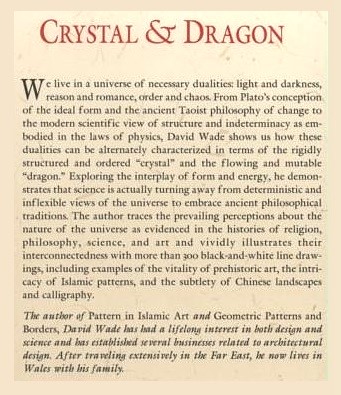|
The symmetry of the line diagrams accounts for the symmetry of the two-color patterns. (A proof shows that a 2nx2n two-color triangular half-squares pattern with such line diagrams must have a 2×2 center with a symmetry, and that this symmetry must be shared by the entire pattern.)
Among the 35 structures of the 840 4×4 arrays of tiles, orthogonality (in the sense of Latin-square orthogonality) corresponds to skewness of lines in the finite projective space PG(3,2). This was stated by the author in a 1978 note. (The note apparently had little effect. A quarter-century later, P. Govaerts, D. Jungnickel, L. Storme, and J. A. Thas wrote that skew (i.e., nonintersecting) lines in a projective space seem "at first sight not at all related" to orthogonal Latin squares.)
We can define sums and products so that the G-images of D generate an ideal (1024 patterns characterized by all horizontal or vertical "cuts" being uninterrupted) of a ring of 4096 symmetric patterns. There is an infinite family of such "diamond" rings, isomorphic to rings of matrices over GF(4).
The proof uses a decomposition technique for functions into a finite field that might be of more general use.
The underlying geometry of the 4×4 patterns is closely related to the Miracle Octad Generator of R. T. Curtis– used in the construction of the Steiner system S(5,8,24)– and hence is also related to the Leech lattice, which, as Walter Feit has remarked, "is a blown up version of S(5,8,24)."
For a movable JavaScript version of these 4×4 patterns, see The Diamond 16 Puzzle.
The above is an expanded version of Abstract 79T-A37, "Symmetry invariance in a diamond ring," by Steven H. Cullinane, Notices of the American Mathematical Society, February 1979, pages A-193, 194.
For a discussion of other cases of the theorem, click here.
Related pages:
The Diamond 16 Puzzle
Diamond Theory in 1937:
A Brief Historical Note
Notes on Finite Geometry
Geometry of the 4×4 Square
Binary Coordinate Systems
The 35 Lines of PG(3,2)
Map Systems:
Function Decomposition over a Finite Field
The Diamond Theorem–
The 2×2, the 2x2x2, the 4×4, and the 4x4x4 Cases
Diamond Theory
Latin-Square Geometry
Walsh Functions
Inscapes
The Diamond Theory of Truth
Geometry of the I Ching
Solomon's Cube and The Eightfold Way
Crystal and Dragon in Diamond Theory
The Form, the Pattern
The Grid of Time
Block Designs
Finite Relativity
Theme and Variations
Models of Finite Geometries
Quilt Geometry
Pattern Groups
The Fano Plane Revisualized,
or the Eightfold Cube
The Miracle Octad Generator
Kaleidoscope
Visualizing GL(2,p)
Jung's Imago
Author's home page
|


















